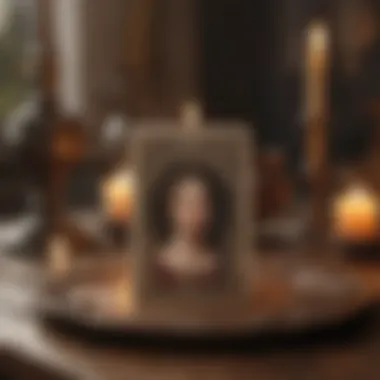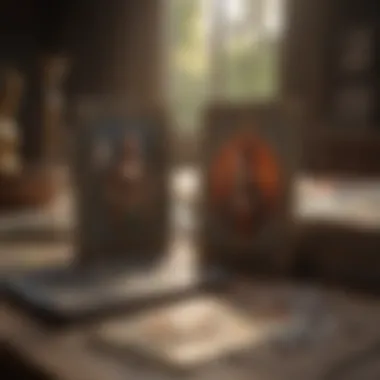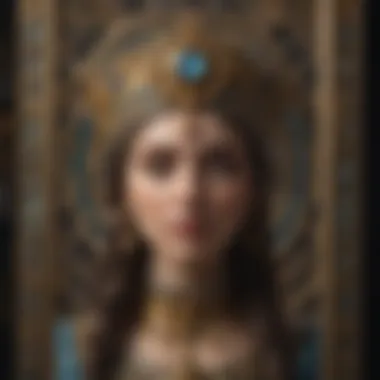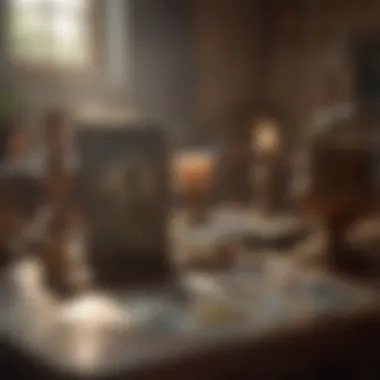Master Tarot Card Reading: A Free Comprehensive Guide


Intro
In today’s world, tarot card reading evolves beyond mere entertainment. It's widely recognized for its potential in self-discovery and insight. Learning this art form increases personal awareness and provides pathways for spiritual growth. This guide serves as a rich resource for those intent on exploring tarot without a monetary investment. You will uncover various facets of tarot whilst engaging in practices that cultivate intuition and interpretative skills.
Characteristics of Each Zodiac Sign
Understanding the zodiac can enhance your tarot readings. Each sign carries distinct traits that can be mirrored in the tarot's symbolism. Here’s a framework detailing key features of each sign:
Overview of Personality Traits
- Aries: courageous and pioneering, but often impulsive.
- Taurus: grounded and reliable, yet can be stubborn.
- Gemini: adaptable and communicative, but sometimes inconsistent.
- Cancer: emotional and nurturing, although prone to mood swings.
- Leo: confident and enthusiastic, yet can be arrogant.
- Virgo: detail-oriented and organized, but often critical.
Understanding Tarot Basics
Tarot card reading has become a popular method for seeking guidance and exploring one's inner self. Understanding the basics of tarot is vital for anyone making an intention to dive deeper into this mystical practice. This section will cover foundational elements such as the history of tarot, the structure of a tarot deck, and the purpose it serves for both readers and querents. Knowledge of these fundamentals provides a more comprehensive perspective as one embarks on the journey of tarot reading.
History of Tarot
Tarot cards have a compelling history that dates back to the 15th century, first appearing in Europe as playing cards. Originally, they held no association with divination. Some scholars argue that they were used primarily for gaming in the Italian courts. As time passed, especially by the 18th century, the perception of tarot changed remarkably. The cards became connected to mystical traditions, especially within the context of Jewish Kabbalah and ancient Egyptian belief systems. This shift sparked interest in their use for fortune-telling, altering the cards’ identity forever.
Understanding the historical context of tarot allows readers to appreciate its transformation from leisure activity to tool for self-reflection and insight. Grasping these elements can deepen one’s connection with the cards.
Components of a Tarot Deck
A standard tarot deck usually contains 78 cards divided into the Major Arcana and Minor Arcana. Each segment serves distinct functions, but both are crucial to reading tarot effectively.
Major Arcana
The Major Arcana consists of 22 cards, each bearing deep layers of significance. Titles include The Fool, The Magician, and The World. These cards represent major life themes, deep experiences, and profound spiritual lessons.
One distinctive feature of Major Arcana cards is their often symbolic nature which invites personal contemplation. As faces of particular existential questions, they resonate with pivotal transitions within human life, providing valuable insights. Thus, they are of huge importanced for readers looking to understand heavier personal matters with depiction of life’s journeys and trials.
Minor Arcana
In contrast, the Minor Arcana comprises 56 cards that focus on day-to-day events and situations. This section is split into four suits: Wands, Cups, Swords, and Pentacles. Each suit connects to specific aspects of human experience, covering everything from emotions to practical matters.
Characteristically, Minor Arcana cards often have varied interpretations based on their context in a spread. They engage tarot readers in addressing fluctuating concerns, thus providing clarity when analyzing life details or short-term inquiries. This aspect encourages practitioners to explore mundane yet critical issues in the quest for a full reading.
Suits and Numbers
Tarot suits and their numbers play an essential role in the reading process. Each suit uniquely represents a different emotional, physical, or spiritual domain, as previously noted. For instance, Wands is generally associated with creativity and passion, while Cups connects to emotions.
Cards within each suit follow a numeric progression, from Ace to Ten, followed by the court cards—Page, Knight, Queen, and King. The numerical patterns in the suits heighten semantic depth, allowing for layered interpretive analysis. Understanding these layers creates a foundational skill that empowers readers to produce meaningful narratives during sessions.
The Purpose of Tarot Reading
Tarot reading fulfills numerous functions which change based on intentions behind it. A primary purpose includes guiding individuals toward self-discovery and enlightenment. Cards, in interaction with the querent's energy, aim to reveal pathways through uncertainties while promoting insights that aid decision making.
Importantly, using tarot to foster personal reflection can build emotional resilience and cultivate deeper connections with the self. Engaging tarot also enables the practitioner to sift through life's complexities by interpreting symbols and stories woven into the card imagery. Confidence grows with proficiency, making tarot a continuously rewarding roadmap for the soul's evolution.
Choosing a Tarot Deck
Choosing the right tarot deck is a significant step in the tarot learning journey. A tarot deck serves as a personal guide during readings, and it influences how one interprets cards. The choice of deck may reflect one's personality, beliefs, or intuitive connection to the images and symbolism represented in the cards. There are many options out there, so understanding the various types of tarot decks available and how to approach the selection process is essential for a meaningful tarot experience.
Types of Tarot Decks
Different tarot decks encompass distinct themes and interpretations, making the selection process quite personal. Here are some common categories:
- Traditional Tarot Decks: These include the Rider-Waite-Smith deck and the Thoth Tarot. They are widely used and accepted in tarot reading. The symbolism and illustrative style in these decks set a foundation for many interpretations.
- Themed Tarot Decks: These might incorporate elements from mythology, culture, or art. Examples include the Wild Unknown Tarot or the Drugstore Cowboy Tarot. Each themed deck generates a different narrative for interpretation.
- Alternative Decks: Such decks diverge from traditional structures, such as using completely ousted illustrations or representations. The Lenormand deck, while somewhat different from standard tarot, focuses on direct readings with a unique perspective.
Deciding on these affects how readers connect with the cards themselves and their intended meanings.
Using Free Online Resources to Explore Decks
Many platformmam offer valuable resources for exploring a wide selection of tarot decks. Websites like Open Tarot systematically compile reviews and details about various decks. Here are some free resources to utilize:
- Reddit has community discussions focusing on deck reviews, where users share experiences and preferences.
- YouTube often features comparative reviews and unboxing videos. Seek content creators who specialize in tarot for real-time impressions.
- Facebook groups provide fertile ground for asking prospective questions regarding specific decks, allowing potential buyers to probe community feedback.


Leveraging these resources can ease your decision-making process and allow you to connect with passionate tarot practitioners.
Personalizing Your Tarot Experience
Finding a deck that resonates with you may lead to a richer tarot reading experience. Here are ways one can personalize their tarot journey:
- Engage Intuition: Notice your gut feelings about a particular deck. If a deck visually connects with you or evokes emotions, it may be worth exploring.
- Consider Artwork and Themes: It can be beneficial to choose a deck whose art reflects themes you relate to or find engrossing.
- Handle the Deck: Whenever possible, physically handle the tarot decks if you can find them in stores or during events. The texture and quality can affect attachment.
- Daily Draws: Simply using the deck regularly for daily card draws or personal readings cultivates a deeper bond and learning about its nuances.
As such, selecting a deck means finding an extension of your influence into the readings you perform, making your learning experience unique.
Ultimately, a well-chosen tarot deck not only taps into tradition but also reflects the reader’s journey. The deck becomes not only a tool for divination but a genuine partner along the learning path.
Essential Tarot Reading Techniques
Understanding essential tarot reading techniques is critical for anyone seeking to master the art. These techniques provide a structured way to interpret the cards, enhancing the reader’s ability to offer insightful readings. Incorporating these principles can lead to more effective and meaningful tarot interactions, whether it’s for personal use or for guiding others.
Understanding Card Meanings
To effectively read tarot cards, one must first grasp the meanings of each card. Each tarot card possesses unique imagery and symbolism that is often influenced by various contexts, including personal intuition. Card meanings can vary based on the situation being addressed. The major arcana cards often represent significant life events or lessons, while the minor arcana delve into everyday occurrences and details.
When learning card meanings, reading from reputable sources is beneficial. One can start with urbanology. Some encourage keeping that guidebook while learning each day.
Interpreting Card Spreads
Interpreting card spreads is crucial for any tarot reading. A card spread defines how the cards are laid out, allowing the reader to derive different meanings based on the position of each card. The following subsections highlight different spreads commonly used by novice and experienced readers alike.
One-Card Spread
The one-card spread is one of the simplest forms of tarot readings. It essentially delivers a distilled message, great for quick questions or daily guidance. This type of spread allows for immediate clarity without overwhelming details. Additionally, it can function as an excellent starting point for newcomers.
Despite its simplicity, its unique feature lies in its focus. Readers often connect deeply with one meaningful card, often giving rise to personal reflections. However, the disadvantage could be a lack of nuanced insights for more complex inquiries.
Three-Card Spread
The three-card spread entails drawing three cards, each representing different aspects—like past, present, and future. This spread is beneficial because it encourages reflective thinking and provides a more comprehensive understanding of the situation.
Its key characteristic is the balance between simplicity and depth. Each card complements the others, establishing a narrative. This interplay offers a chance for deeper exploration - but it might still simplify a more complicated situation due to its limited card number.
Traditional Spreads
Traditional spreads, such as the Celtic Cross, consist of multiple cards placed in designated positions to define specific meanings. Their key characteristic is their elaborate structure, allowing for detailed interpretations.
While offering rich insights, the disadvantage lies in complexity. It can confuse beginners as they try to remember both the positions and their meanings. Successful navigation requires experience and practice to harness their full potential effectively.
Intuitive Reading Practices
Intuitive reading practices play an essential role in developing a personal reading style. Readers are encouraged to trust their gut feelings instead of strictly following traditional meanings. This approach fosters a deeper connection with each card and helps readers uncover their unique interpretations.
Upon honing intuitive skills, readers may find they rely less on guidebooks and focus more on the personal resonance cards hold. Each interaction becomes a dialogue rather than merely interpreting fixed meanings. Through careful practice, improved intuitive insights contribute greatly to informed and powerful tarot readings.
Free Learning Resources for Tarot Reading
Free learning resources for tarot reading play a critical role in making tarot accessible to everyone. By utilizing these resources, aspiring readers can develop their skills without financial burden. This segment addresses a variety of platforms that offer valuable content and guidance. Through these mediums, newcomers encounter foundational knowledge while seasoned practitioners find opportunities for enrichment.
Online Courses and Tutorials
Online courses and tutorials have immensely transformed the learning landscape. Free offerings from various educational platforms provide structured learning paths. Sites like Coursera or Udemy occasionally allow free access to materials related to tarot. Additionally, independent sites often have free introductory courses that offer great insight.
A few advantages include:
- Structured Content: Lessons arranged logically aid in understanding.
- Diverse Approaches: Various instructors can provide different perspectives on reading.
- Interactive Elements: Many of these courses include quizzes and forums for discussion, giving a sense of community.
Before diving in, it's wise to evaluate course syllabi and reviews. This helps ensure the chosen resource aligns with your learning objectives.
YouTube Channels for Tarot Education
YouTube serves as an engaging platform for tarot education. Many channels offer practical lessons on card meanings, spreads, and intuitive reading. Following several channels encourages viewers to explore different interpretations of the same material.


Some sought-after channels include:
- Little Red Tarot: Focused on diverse readings and inclusivity.
- The Tarot Lady: Offers straightforward instruction and informative content.
- Tarot with Lynda: Known for accessible explanations of card symbolism.
YouTube differs from formal courses by allowing viewers to stop and replay sections. This makes it easier to digest complex topics or revisit specific moments in discussions. Engaging with the content while actively practicing ensures a deeper learning experience.
Virtual Tarot Communities and Forums
Assisting learning is the vibrant existence of virtual tarot communities and forums. Platforms like Reddit and Facebook have groups where individuals share insights, experiences, and challenges. Engaging in conversations with peers creates an enriching learning environment.
Some benefits of participating in these forums include:
- Feedback: Fellow tarot enthusiasts offer constructive feedback which enhances learning.
- Shared Experiences: Learning from others’ readings enriches your understanding of varied interpretations of cards.
- Resources: Many users frequently share links to articles, courses, or videos which can be beneficial for learners.
Participating in discussions and sharing readings establishes a continuous circle of learning, ensuring both intellectual and practical growth in your tarot reading journey.
Engaging with free resources can remove barriers to learning tarot, encouraging both personal and communal growth in this art.
Developing Your Tarot Reading Skills
Developing effective tarot reading skills is crucial for anyone wishing to engage deeply with tarot. This aspect not only enriches your understanding but also enhances the overall reading experience. In this journey, practice, reflection, and peer support play essential roles. You'll naturally improve the quality of your tarot sessions and foster confidence in interpretations. The following subsections elucidate key methods to nurture these skills.
Regular Practice with Tarot
Regular practice is the foundation of becoming a proficient tarot reader. Like any art or science, tarot demands consistent engagement to understand its intricacies fully. By drawing cards daily or weekly, you get to familiarize yourself with individual card meanings. You will notice how different cards interact with each other and develop insights about their collective significance.
Practical methods to incorporate regular practice include:
- Daily Card Pulls: Draw one card daily to reflect on its meaning throughout the day. Take notes on how it manifests in your life.
- Weekly Free-Form Sessions: Conduct a casual reading for yourself or a friend. Spend time interpreting combinations of cards.
- Themed Practices: For instance, focus on love-related topics one week, followed by career aspirations the next.
This routine not only builds your knowledge but also strengthens your intuition as you learn to recognize patterns over time.
Keeping a Tarot Journal
Keeping a tarot journal can considerably enhance learning outcomes. This journal serves as a personal repository for insights, experiences, reflexions, and evolving interpretations. Recording your readings allows for reflection upon past sessions and growth in your interpretations.
Considerations for effective journaling include:
- Recording Draws: Document every reading, specifying what you asked and the card meanings.
- Reflective Analysis: Daily or weekly reflections on what worked well and what did not.
- Monitor Progress: Review earlier entries to observe your evolution and newfound understanding of tarot.
By reviewing these entries periodically, you will recognize maturity in your reasoning and understand recurring themes or questions that present themselves.
Seeking Feedback from Peers
An often-underrated aspect of personal development is the input from others. Feedback from fellow tarot readers can enhance skill significantly. By sharing practices in communities, you receive constructive observations and advice which can include familiarity with particular spreads, nuanced meanings of cards, or relational themes that you might be missing.
Ways of seeking feedback include:
- Joining Online Forums: Websites like Reddit hold communities where readers of all levels share insights and critiques.
- Participating in Study Groups: Engaging in real-time discussions allows for a shared atmosphere of learning.
- Offering Readings: Practice reading for peers and ask for specific feedback about your interpretations.
This exchange of ideas can unveil different approaches, inspiring creativity, and elevating sensitivity in readings.
Regularly applying these strategies cultivates a promising environment for development, paving the way for improved tarot reading skills and personal clarification.
Understanding Ethics in Tarot Reading
Ethics are crucial in tarot reading, shaping how a reader interacts with clients and upholding the integrity of the practice. Understanding ethics involves clarity about responsibilities and expectations as a reader. This knowledge builds trust, fosters a safe environment, and enhances the overall experience for both the reader and the querent (the person seeking guidance).
The key elements include setting boundaries, maintaining confidentiality, and acknowledging one’s limitations.
Setting Boundaries as a Reader
Establishing clear boundaries is essential for maintaining a successful tarot practice. Boundaries protect both the reader and the querent, helping to create a professional atmosphere. Clear demarcations can reduce the risk of misunderstandings or inappropriate questions.
Moreover, effectively communicating what type of readings you offer, and what is off-limits, fosters mutual respect. Readers should think about time limits, sensitive subjects, and sticking to questions rooted in self-improvement rather than seeking definitive answers regarding others' lives.
In your practice, marking these outlines can help with:
- Avoiding emotional overwhelm
- Offering focused guidance
- Enhancing the satisfaction for all parties involved


Confidentiality and Respect
Confidentiality stands at the core of any ethical practice in tarot. If clients share private details during readings, it is necessary to honor that trust. There is no room for disclosing personal information shared in confidence. Consider this ethical aspect 非contvocreate a respectful connection. Respect ensures clients feel safe, making them more open to receiving the insights provided.
Proper handling of sensitive information translates into:
- Building a reliable reputation
- Attracting clients who value trust
- Creating lasting relationships that can evolve over time
Knowing Your Limitations
Recognizing and acknowledging your limitations is a significant aspect of ethical tarot reading. Each reader has different proficiency levels, and it is vital not to venture beyond your scope. Users seek tarot readings for insights, meaning the reader must know how to provide those without crossing personal or professional lines.
Contemplate these key considerations regarding limitations:
- If unsure about a card's meaning, researching before giving a reading is a prudent choice.
- Should questions arise around medical or legal matters, refer clients to qualified professionals rather than attempt to provide guidance outside your expertise.
- Ensure continual learning about tarot and spirituality, which help expand your skillset and limit interpretative errors.
Understanding one’s boundaries, confidentiality concerns, and personal limits creates a respectful and ethical reading experience, promoting healthy interactions in the tarot community.
Expanding Beyond Basic Reading
Expanding your skills in Tarot reading is crucial for those who wish to delve deeper into the complex relationships between cards and their meanings. Moving beyond basic interpretations opens a myriad of new possibilities that can enrich readings significantly. It is essential to recognize that Tarot is not just a tool of divination but can also serve as a powerful catalyst for personal growth and exploration.
By expanding your study, you invite layers of meaning and symbolism into your practice. The approach to card interpretations can evolve through understanding how historical, psychological, and astrological aspects inform readings. When you grasp these deeper layers, your resonances with specific cards may develop uniquely, enhancing the readings you offer to yourself and others.
Advanced Card Interpretations
Advanced card interpretations require a solid grasp of the foundational meanings of the cards in both the Major and Minor Arcana. Recognizing subtle relationships among diversified cards is equally important. Each card does hold its symbolism, yet also, they work well together in diverse spreads.
Developing advanced skills means interpretintr all the aspects that can emerge from a single arrangement. Here are some elements to focus on:
- Symbolic Relationships: Look for connections and narratives between cards in a spread. How does a card like The Tower interplay with The Fool? Determining these relationships gives a reading depth.
- Intuition and Experience: Trusting your feelings about a card's placement and energy can lead to insights that formulas might not divulge. This personal understanding creates a style and approach that is uniquely yours.
- Contextual Elements: Consider the sitter's query or the situation’s backdrop when providing interpretations. Contextual awareness can often alter readings significantly.
Staying curious and developing your intuition will enhance your Tarot reading skills. Continual exploration ensures robust personal insights develop over time.
Integrating Astrology with Tarot
Astrology and Tarot are interlaced in ways profound and transformative. Each Tarot card aligns with astrological symbols, giving deeper meaning to celestial influences on personal experiences. Familiarizing yourself with this synthesis can greatly expand your deck’s interpretive value.
To incorporate Astrology:
- Card Associations: Each card is linked to particular zodiac signs and planets. For instance, The Emperor corresponds with Aries and embodies leadership qualities.
- Astrological Transits: Understanding the current astrological events can inform your readings. In what ways does the Moon phase reflect emotional periods for the querent?
- Personal Birth Charts: Applying personal astrological metrics to the Tarot's meaning can reveal insights not only about others but also for oneself, promoting personal growth.
Ultimately, integrating Astrology with Tarot enriches your practice, yielding uniquely profound interpretations anchored in celestial awareness.
Using Tarot for Personal Development
Utilizing Tarot for personal development is perhaps one of the most rewarding facets of this practice. It is more than a method of divination; it serves as a valuable pathway for individuals looking to navigate life's complexities.
Considering personal development with Tarot encourages introspection and growth. Here are several ways Tarot can contribute:
- Self-Reflection: Regular readings create an opportunity for solitude and contemplation. This space is essential for growth.
- Goal Setting: Tarot can assist in clarifying personal aims. Utilizing specific cards shifts focus toward achieving those aspirations. For instance, The Chariot could relate to perseverance toward a project or goal.
- Emotional Awareness: Card readings dive into emotions and undercurrents shaping your reality. Medication on emotional impacts encourages responsiveness to one's own feelings and experiences.
In summary, not only does Tarot as a practice inform future encounters, but also it encompasses significant elements of one’s emotional and spiritual journey. As skills develop in Tarot reading, expanding horizons turns reading into ripe engagements for personal and collective growth.
The End
The conclusion of this guide on learning tarot card reading is significant in cementing the understanding and application of the skills discussed throughout the article. It serves as a summary, bringing together the trails of thought and practices covered, while simultaneously paving a path forward in readers’ tarot journeys.
Recap of Learning Path
To successfully learn tarot reading, it is essential to recap the foundational steps, which include:
- Understanding the basics of tarot: Recognizing the history and components enhances appreciation.
- Choosing the right tarot deck: Personal preferences in symbolism and imagery strongly influence engagement.
- Mastering essential reading techniques: Interpreting meanings and card spreads empowers insight delivery.
- Engaging with free resources: Online courses, YouTube channels, and communities allow for diverse learning experiences.
- Nurturing your skills through regular practice: Maintaining a tarot journal and seeking feedback supports improvement.
- Recognizing the ethical dimensions: Important for respect and accountability in readings.
- Expanding knowledge through advanced techniques and applications enriches practice.
By reflecting on these steps, readers can gauge their current position in the tarot learning journey and identify areas for further exploration or practice. Integrating feedback from both self-assessment and peer interaction will only solidify their growing command of the tarot.
Encouragement for Continuous Learning
The world of tarot is expansive and ever-evolving. Mastery is not a destination; it is a journey filled with discovery. Therefore, continuous learning is imperative. Here are a few recommendations for enhancing skills:
- Join tarot workshops: They offer hands-on experience and elevate understanding through interaction with instructors and fellow learners.
- Follow publications and blogs centered on tarot: Staying current provides insight into trends and innovative reading techniques.
- Participate in online communities: Platforms such as Reddit and Facebook host numerous groups where enthusiasts share experiences, leading to rich discussions and knowledge exchange.
In closing, engagement with tarot is not merely a pursuit but a deep exploration of oneself and the universe. Continue to seek new paths of knowledge, remain curious, and during this journey, find your unique voice within the tarot’s vast language.







